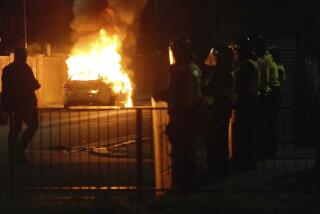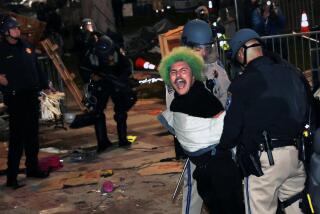British examine crowd control at summit protests
- Share via
LONDON — Thousands of people were held against their will. Pleading didn’t work, neither did shouts or tears. Penned in for hours, some were forced to urinate in public. Others phoned spouses and bosses in mounting frustration as police ignored their requests to be allowed to leave.
The British call it “kettling,” and it describes how authorities cordoned off and contained the masses of demonstrators -- and plenty of bystanders -- this month in central London during protests against a global economic summit.
But the practice is under fire from those who see it as tantamount to mass detention, a recipe for inflaming public anger instead of assuaging it. The British police, once admired the world over for the cheerful efficiency of its helmeted “bobbies” and a tradition of excellence at Scotland Yard, have agreed to reexamine kettling as part of a wider investigation of abuse allegations from the protests.
A top government official said Tuesday that some officers had acted in an “utterly unacceptable” manner by concealing their badge numbers during the demonstrations. Worse, several amateur photographs and videos have surfaced showing police officers apparently knocking down and beating mostly peaceful participants.
One man, a newspaper vendor who hadn’t taken part in the demonstrations, died of internal bleeding shortly after being knocked to the ground by an officer. Other video showed a young woman being struck across the legs by a police baton -- she likened it to being “whipped by the Taliban” -- and another being smacked on the back of the head by a riot shield.
Called to give evidence before lawmakers, Nick Hardwick, chairman of the Independent Police Complaints Commission, said Tuesday that his office had received more than 50 complaints “where either people are saying they were victims of an assault or they are saying they directly witnessed an assault” by police officers.
The growing scandal is another blow to a force rocked in recent years by accusations of racism and incompetence in the case of a Brazilian plumber who was shot to death in 2005 on the London subway by officers who misidentified him as a terrorism suspect.
Britons last week commemorated the 20th anniversary of the nation’s worst sporting disaster, in which more than 90 people were crushed and trampled to death at a soccer stadium in the city of Hillsborough. The police came in for heavy criticism afterward for their crowd-control tactics.
The specter of Hillsborough certainly hung in the air during the April 1-2 protests for the Group of 20 meeting in London, an economic summit attended by President Obama and other leaders.
Thousands of people flocked to London’s financial district the morning of April 1 for a raucous but peaceful rally outside the Bank of England. Within a couple of hours, however, the kettling began, with rows of neon-jacketed police officers sealing off the streets and hemming everyone in.
On one side street, scores of people grew increasingly agitated as officers refused to let anyone pass in either direction. To an American reporter on the scene, the anger was almost palpable as the sun beat down, patience frayed and bladders pressed.
“Kettling” seemed an apt description for the tempers that were close to boiling over among people who wanted to leave the demonstration, not stay on and give the police trouble.
“Let us out! Let us out!” the crowd chanted.
The police were unmoved, turning away one desperate young woman who pleaded to be allowed to return to her nearby office after having been accidentally caught behind the cordon as she walked back after lunch.
Another woman lambasted police for detaining law-abiding protesters in such a manner, which could prove dangerous if there were a stampede. To cheers, she shouted at police to remember “the lessons of Hillsborough.”
Only a pregnant woman who was visibly shaking and near tears was given permission to leave the site.
It was nearly three hours before police relaxed the cordon and allowed the crowds to disperse.
Authorities contend that kettling is the most effective way of preventing protests from spiraling out of control and becoming a rampage. Britain’s highest judicial body upheld the legality of the practice this year, despite criticism by civil liberties groups that it amounted to mass detention.
But it is under the microscope again, thanks in part to demonstrators whose cellphone cameras and text messages helped capture and publicize what happened at the G-20 protests.
It was a grainy video by an American visitor that forced police officials to open an investigation of the death of newspaper vendor Ian Tomlinson, after initial claims that he had had no contact with police and had collapsed with an apparent heart attack.
In the video, as Tomlinson walked away from the protest site, his back to the police and his hands in his pockets, an officer can be seen shoving him hard and sending him sprawling. An autopsy found that Tomlinson suffered massive internal bleeding.
In other video, an officer refuses to tell someone his badge number, which is against police regulations, and other officers appear to have their badge numbers obscured.
“It’s utterly unacceptable, and that’s it. There is no explanation for people not to be wearing their numerals,” Denis O’Connor, the incoming chief inspector of constabulary, told lawmakers in Parliament on Tuesday.
O’Connor is leading the inquiry on police handling of the G-20 protests. His report is expected in a few months.
--
More to Read
Sign up for Essential California
The most important California stories and recommendations in your inbox every morning.
You may occasionally receive promotional content from the Los Angeles Times.














